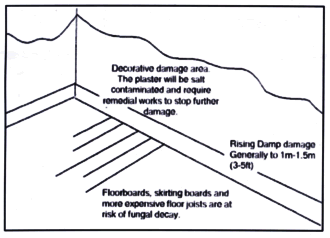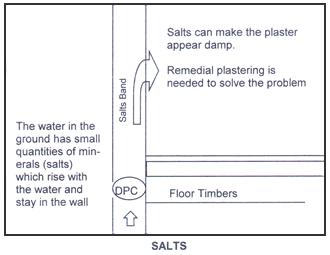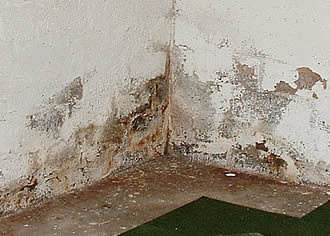
Dampness and Condensation
As well as sometimes causing timber problems, houses can suffer from damp. Dampness may be caused, amongst other things, by Rising Damp,
Penetrating Damp and Condensation.
Signs that you may have a problem can include decorative damage, blistering plasterwork or just a plain damp patch.
|

|
RISING DAMP |
One of the more common problems is Rising Damp. It tends to affect houses built 60 or more years ago before the sorts of barriers we
have today to prevent water rising up the walls were in use. Such houses, probably built directly onto the ground may at best have only
a layer of slate to keep out the wet.
An additional problem is that rising water contains minerals which crystallise as salts.
Over a long period these salts form visible and invisible deposits, which attracts water in
humid conditions. Plasterwork becomes contaminated and will cause damage to decoration and can put timbers at risk.
Remedial plaster systems are used to prevent salts damaging internal decoration.
|

|
|
Treatment
A chemical Damp Proof Course (DPC) is injected into the walls. The affected walls are drilled at the correct height and a monitored quantity
of chemical Damp Proof Course fluid is injected into the wall, this suppresses the rising water.
Vertical Damp Proof courses can also be used to prevent damp moving sideways. If salt deposits are a problem, these may need additional
treatment with special rendering and plasterwork.
Types of Damp Proof Course
Active Services are able to install electrical and mortar Damp Proof Courses where either the construction of the wall requires or to keep the
property chemical free.
|

|
PENETRATING DAMP |
Penetrating Damp describes the action of water entering and moving through a wall. This generally happens when rainwater goods, such as gutters
and down pipes are defective, where pointing, external rendering and chimneys are faulty or where roof slates have become dislodged or cracked.
This type of dampness needs very careful investigation, as the cause of the problem is not always obvious. Water can move a considerable distance
horizontally before appearing on the surface.
Treatment
Problems caused by leaking and blocked gutters and down pipes are easily remedied.
Internal damage in an older house may require re-plastering as the original plaster is often contaminated. Where this is so, humid weather is
sufficient to cause decorative damage. After the leak is stopped, drying can take a considerable time.
|
DAMP FLOORS |
Some floors are laid without a Damp Proof Membrane. Active Services are able to provided a dry floor using an Epoxy surface membrane
without either changing the level more than 2 mm or causing disruption by laying a new floor.
|
UNDERGROUND WATER DAMAGE |
In Devon and Cornwall, counties well known for their annual rainfall, houses are often built into hillsides and partially below ground.
Inevitably because of this water can get into a house through the underground sections of the walls.
The resulting damage can ruin decoration and give rise to flooded basements and cellars.
Treatment
To prevent subterranean damage, a system known as 'tanking' or more correctly 'structural waterproofing' can be employed.
As this name implies, this is a term used for creating a water tank to hold this water out at the affected section of the property.
|
|
There are two main methods of waterproofing. The first consists of applying a waterproof coating within the walls to hold the water out.
The second requires the creation of a barrier inside the walls which not only keeps the water out but also drains it off.
These systems can bring a dank cellar fully into the house as a warm, dry space. Active Services can advise you on which method to use for your space
and to fit the use for your new area..
|
 |
CONDENSATION |
There is always water vapour in the air. The amount of it that can be carried in the air depends upon the room temperature. As temperatures fall,
often at night, the air will not support the moisture and it is deposited on the cold surfaces such as windows and exterior walls.
Modern lifestyles have increased problems caused by condensation; we use showers, tumble driers and washing machines more than our forebears.
Fewer houses have large open fires which can suck up the moist air, and double glazing prevents water vapour from escaping.
Regular soaking through condensation can cause considerable and costly decorative damage and risk particularly to expensive decoration and clothes.
There is also evidence that condensation increases the risk of Asthma and other chest problems.
|

|
|
|
Treatment
Active Services fit 'Positive Pressure' ventilation. This unit fits into the roof space giving a continual very gentle flow of dry air from the
loft into the house. This unit is adjustable for any size of house.
As the flow of air is introduced to the ceiling it mixes this warm layer of air back into the house. Only very small amounts of electricity
are used to run the unit - less than a low powered light. These units have a three month money back warranty that condensation will be controlled.
For Flats without a loft space available a similar unit can be mounted on the wall.
The advantage with all these units is they virtually need no further attention and provide continuous use for many years.
|
DAMPNESS CAN BE A HIDDEN ASSET!
We hope that this will give you a pleasant surprise! From all that we have said above, you will realise that roofs and
basements can be a major source of trouble. However, corrective action resulting in a bone dry roof void and a dry cellar
may allow you to create a further living accommodation in these areas. It is certain that you must cure the damp problem.
It is almost equally certain that at a little extra cost you can add space to your house.
|

|













